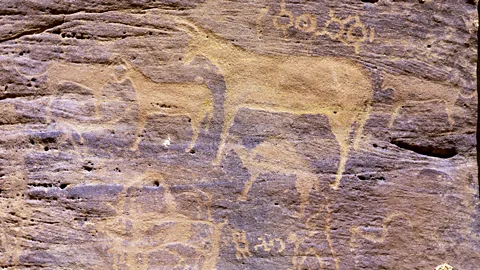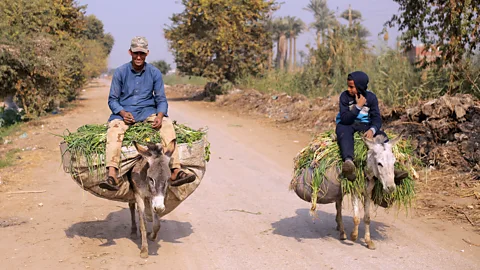How donkeys changed the course of human history
 Ase Ording Reinisch/Alamy
Ase Ording Reinisch/AlamyFrom bearing the burdens of the Roman Empire to enabling trade over long distances, the humble donkey has been surprisingly influential.
They are best known for their remarkable ability to carry heavy loads and a tenacious – almost stoic – approach to toil. In some parts of the world, the donkey has become associated, perhaps unfairly, with terms of insult or mockery. But in a French village around 174 miles (280km) east of Paris, archaeologists have made a discovery that is helping to rewrite much of what we know about these under-appreciated beasts of burden.
At the site of a Roman villa in the village of Boinville-en-Woëvre, a team unearthed the remains of several donkeys that would have dwarfed most of the species we are familiar with today.
"These were gigantic donkeys," says Ludovic Orlando, director of the Centre for Anthropobiology and Genomics of Toulouse, at the Purpan Medical School in Toulouse, France. "These specimens, which were genetically linked to donkeys in Africa, were bigger than some of the horses."
Orlando has been leading a project that sequenced the DNA from the donkey skeletons. It was part of a much larger study to trace the origin of domestication of donkeys and their subsequent spread to other parts of the world. The research is providing surprising insights into the history of our own species through our relationship with these versatile animals.
According to Orlando, the donkeys bred at the Roman villa in Boinville-en-Woëvre measured 155cm (61in, or 15 hands – a unit for measuring horse height) from the ground to the withers (a ridge between the shoulder blades). The average height of donkeys today is 130cm (51 inches/12 hands). The only modern donkeys that might have come close are the American Mammoth Jacks – male donkeys that are unusually large and often used for breeding stock.
 Eric Lafforgue/Getty Images
Eric Lafforgue/Getty ImagesGiant donkeys like those found at Boinville-en-Woëvre may have had an important but under-appreciated role in expanding the Roman Empire and its later attempts to hang onto its territory, says Orlando.
"Between the 2nd and 5th Century, the Romans bred them for producing mules [by cross breeding them with horses] which played a key role in transporting military equipment and goods," he says. "Though they were in Europe, they were bred and mixed with donkeys coming from western Africa."
But changes in the fortunes of the Roman Empire probably were instrumental in this giant breed of donkey disappearing too.
"If you don’t have an empire thousands of kilometres wide, you don’t need an animal that carries goods over huge distances," says Orlando. "There was no economic incentive to continue producing mules."
You might also like:
To trace how donkeys have played their part through human history, an international team of 49 scientists from 37 laboratories sequenced the genomes of 31 ancient and 207 modern donkeys from all over the world. Using genetic modelling techniques, they were able to trace changes in the donkey population over time.
They found that donkeys were most likely first domesticated from wild asses – probably by pastoralists – around 7,000 years ago in Kenya and the Horn of Africa, East Africa. While this is slightly earlier than previously believed, perhaps more surprisingly, the researchers also concluded that all modern donkeys living today appear to be descended from this single domestication event.
Previous studies have suggested, however, that there may have been other attempts at domesticating donkeys in Yemen. Interestingly, this first domestication of donkeys in eastern Africa coincided with the aridification of a once-green Sahara. An abrupt weakening of the monsoon from around 8,200 years ago combined with increased human activity in the form of grazing and burning, led to a decrease in rainfall and the gradual spread of the desert and the Sahel region. Domesticated donkeys may have been crucial for adapting to this increasingly harsh environment.
"We believe due to the climatic changes, the local [human] populations had to adapt," says Orlando. "In donkeys, they could leverage an essential service of transporting large amounts of load over long distances and difficult landscapes."
They noticed that the donkey population also appears to have undergone a dramatic decrease in population size after it was initially domesticated, before sharply increasing again. "This is something typical of domestication and seen in almost every domesticated species at a point in time," says Evelyn Todd, a population geneticist at the Centre for Anthropobiology and Genomics of Toulouse, who was also involved in the study.
The decrease is the result of selecting a specific stock of donkeys for domestication and later breeding it purposely, which contributed to their sharp increase.
Their analysis suggests that donkeys then appear to have radiated out from East Africa, being traded northwest to Sudan and onwards into Egypt, where the remains of donkeys have been found at archaeological sites dating back up to 6,500 years ago. Over the following 2,500 years, this new domesticated species spread throughout Europe and Asia, developing the lineages that are found today.
According to archaeologist Laerke Recht at the University of Graz in Austria, donkeys made a huge difference in humanity's ability to transport goods over long distances by land due to the animals' endurance and ability to carry heavy burdens.
"While rivers such as the Euphrates and Tigris in Mesopotamia and the Nile in Egypt could be used for transport of heavy and/or bulk goods, donkeys meant a massive increase and intensification of contacts over land," she says.
Recht says this coincided with the increasing use of bronze during in the third millennium BC. "Donkeys could carry the heavy copper over long distances and into areas where it could not be found naturally (or only in very small amounts), including Mesopotamia," she says.
 Ismail Duru/Getty Images
Ismail Duru/Getty ImagesBut donkeys and other equids also changed warfare during the same era. "We started to see them in front of wheeled vehicles taking part in battles, as well as providing transport for the provisions needed for an invading army," says Recht.
Donkeys were so highly valued that they even featured in important rituals. "In both Egypt and Mesopotamia, donkeys were considered important enough to be buried with humans, in some cases, even with kings or rulers," says Recth. "There are also examples of donkeys buried in their own right."
She adds that in the second millennium BC donkeys were also sacrificed for so-called foundation or building deposits, and as part of a ritual associated with the signing of treaties.
The oldest sample to be studied by Orlando and his colleagues were three donkeys from the bronze age in Turkey. "They are radiocarbon dated to 4,500-years-old and have a genetic makeup similar to the modern Asian sub-populations," says Todd. It suggests the Asian sub-population of the domesticated donkey split from other lineages around this time.
The research also confirms that donkeys have been a far more constant companion of humans than their equine relatives, horses. "Modern domestic horses, which were domesticated around 4,200 years ago, have had such a big impact on human history," says Orlando. "Now, our study reveals the impact of donkeys extends even further."
The animal's lasting utility sits somewhat in contrast to the amount of attention it has received compared to horses and dogs. While today donkeys are largely overlooked in many parts of the world, in some places, however, they are still as important as they ever were.
 Fadel Dawod/Getty Images
Fadel Dawod/Getty Images"The donkey is an important animal in the daily lives of millions of people throughout the world," says Todd. "Its population is increasing by 1% each year. Although in developed countries, donkeys aren’t used in daily lives, in many developing communities in regions including Africa and the Arabian peninsula, people still rely on donkeys for movements of people and goods."
She adds that understanding the genetic makeup of donkeys could also help to improve their breeding and management in the future.
One key question the researchers are hoping to address in future studies is to find a close relative of the domesticated donkey in the wild. Orlando, Todd and their colleagues were able to identify three candidates. "We know the donkey is a descendant of the African wild ass," says Todd. "There are three subspecies we know about: one of them went extinct in 200AD in Roman times, the second is probably extinct in the wild, and the third is critically endangered."
More work is needed, however, to know if there were or are other as yet unidentified sub-species of the African wild ass which would help further improve our understanding of the genetic history of the donkey and perhaps reveal more about the important role they have played in our own history.
--
